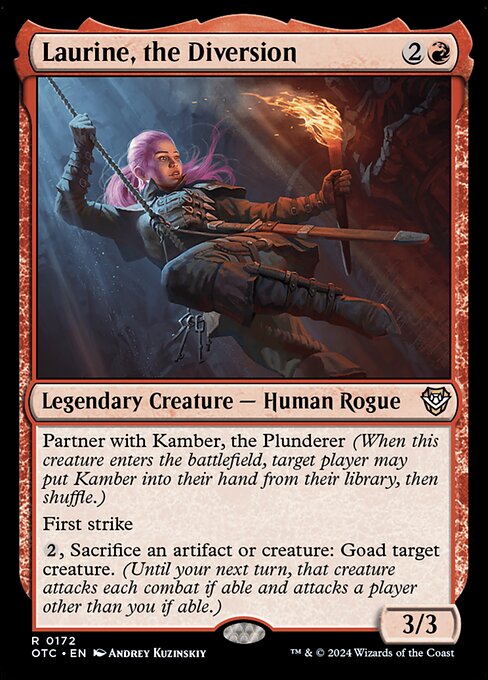
Image courtesy of Scryfall.com
Art and Production Behind Laurine, the Diversion
Every legendary creature card carries a story that goes beyond the battlefield and into the studio, and Laurine, the Diversion is no exception 🧙♂️. Crafted by the deft hand of Andrey Kuzinskiy, this red-aligned rogue speaks in lines as sharp as a cutpurse’s smile. The artwork treats Laurine not simply as a combatant but as a figure of cunning, a human rogue who thrives on misdirection and the thrill of a well-timed gambit. The composition balances motion and stillness—Laurine poised in mid-step, cloak fluttering, eyes locked on an unseen mark—so that when you read her ability text, the illustration feels like a lived moment rather than a still life 🔥.
From a production standpoint, the piece leans into a high-contrast palette that leans heavily on warm reds and amber highlights. This is not just color for color’s sake; it’s a deliberate cue to players that Laurine embodies heat, risk, and tempo. The first-strike keyword is a natural match for the art’s sharp angles and the sense that Laurine is always a beat ahead of her rivals. The goad ability—requiring sacrifice of an artifact or creature—feels like a calculated trap laid in a single, gleaming motion. In the studio, you can imagine Kuzinskiy layering light sources to create dramatic three-quarter illumination, then using glows and airbrush textures to push Laurine forward from the canvas while the background recedes like a whispered conspiracy ⚔️.
But the artistry doesn’t stop at portraiture. Laurine’s “Partner with Kamber, the Plunderer” text is a reminder that this pair was designed to dance in the maelstrom of Commander games. The pairing is not merely mechanical flavor; it invites players to think in terms of alliance-building, political plays, and shared destinies. The production team likely considered how the card’s margins, typography, and border treatment would harmonize with Kamber’s own frame, ensuring that when these two legendries appear side-by-side in a deck, they read as a cohesive chorus rather than two soloists. It’s a subtle but important decision—the kind of detail that elevates a card from “nice to have” to “worth drafting around” 🧠💎.
Design notes that breathe life into the game
- Color and cost: Laurine’s red mana cost ({2}{R}) anchors her in a fast, aggressive space where tempo matters as much as raw power. Her 3/3 stats are sturdy for a 3-drop and leave room for spicy plays with Kamber’s synergy.
- Key abilities: First strike gives Laurine an edge in combat, while Goad—via the sacrifice of an artifact or creature—turns a single moment into a crippling distraction for opponents. It’s the kind of control-in-utility that makes Commander games feel narrative, not just numerical.
- Mechanics with texture: The Partner keyword paired with Kamber, the Plunderer creates a story about choice and exchange—reading as much lore as library manipulation. When Laurine enters with Kamber in hand, your group gets a promise: the thrill of a plan that might tilt the table in your favor, if you read the room right 🧭.
- Rarity and access: As a rare card in the OTC set, Laurine sits at a desirable intersection of playability and collectibility, making her a favorite for both players who love tinkering with red’s speed and fans who chase nostalgic, double-sleeved combos 🎲.
- Artistic signature: Kuzinskiy’s signature crisp linework and confident character silhouettes help Laurine feel like a real personality—someone you’d want to see over the table again and again, especially when she starts stirring the pot 🔥.
For players who adore the whisper-thin line between social politics and battlefield dominance, Laurine also serves as a reminder of how card design can encourage memorable moments. The Goad trigger, when paired with Kamber’s presence, often leads to tense, high-stakes turns where a single sacrifice reshapes the entire board state. It’s the kind of interaction that makes Commander games feel cinematic—where every decision echoes across the table and into the memory banks of your playgroup 🎨.
Playing Laurine in the right shell
In practice, Laurine shines when you lean into artifact-heavy or creature-rich decks that can sacrifice value for tempo. A Kamber-Laurine pairing rewards you for planning around your opponents’ boards—goading a blocker here, nudging a walker there, and using first strike to pick up a tempo swing on pivotal turns. Since Kamber can yank into the hand via Laurine’s enter-the-battlefield synergy, you can set up two-card sequences that feel almost like a heist in mid-combat. The trick is timing: hold your goad activation until you know where the biggest threat is coming from and use the ability to force a pivot in someone’s strategy. The payoff is both strategic and satisfying, with that classic MTG moment when all the pieces click into place 🧭⚔️.
And yes, the card’s production history matters to collectors and superfans. The set’s black-bordered frame, the oval security stamp, and the illustrated signature by Kuzinskiy all signal a piece designed for enduring love in Commander circles. If you’re hunting for a red-hot, political rogue with clear value in both gameplay and lore, Laurine is a strong candidate that doesn’t shy away from a little misdirection and mischief 🔥💎.
Custom Vegan PU Leather Mouse Pad – Non-Slip BackingMore from our network
- https://crypto-acolytes.xyz/blog/post/craving-coins-the-psychology-behind-virtual-currency-purchases/
- https://crypto-acolytes.xyz/blog/post/minecraft-horse-breeding-guide-tame-breed-and-train/
- https://transparent-paper.shop/blog/post/unlock-realistic-seamless-textures-in-photoshop-a-quick-guide/
- https://blog.digital-vault.xyz/blog/post/blazing-blue-white-giant-in-sagittarius-at-33-kpc/
- https://crypto-acolytes.xyz/blog/post/how-bitcoin-protects-wealth-in-hyperinflation-countries/